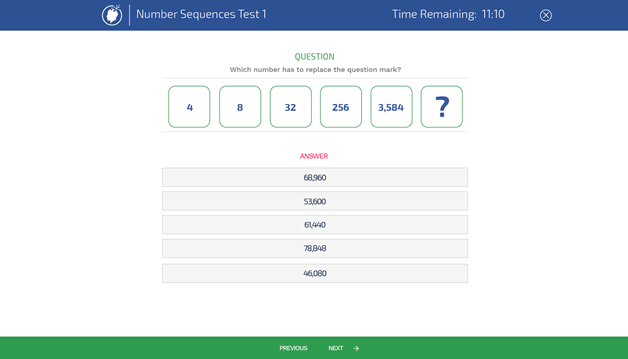Employers choose to use psychometric testing during their recruitment process to help give a better overall evaluation of candidate’s and their suitability for the job that they’re applying for. Psychometric testing could help to gauge the future performance of candidate's and also improve employee retention by making successful hiring decisions.
The most common way for employers to use aptitude tests such as number sequences, is online. Traditionally, aptitude tests have taken the form of pen and paper but due to benefits such as saving valuable time and money, online testing is used more and more frequently. Undertaking aptitude tests is usually the follow-up action after an employer has accepted your CV or initial job application form.
If you pass the online test in some cases you are invited to an assessment centre, which is usually done by larger employers. The term assessment centre is used due to the fact that employers conduct these extended assessment in a single centre, either an office of the employers themselves or at a third party venue. The assessment centre is often (but not always) a day that constitutes the final stage of the application process. At the assessment centre they will ask you to sit a repeat test at the assessment centre to verify your earlier test scores, therefore don’t get your friends or family to help you out during the online test!
Preparing for an assessment centre or online aptitude test can be stressful due to the fact that you don’t know what to expect. The best way to familiarize yourself is with practice aptitude tests that mimic the tests used by employers and recruiters. Assessment-Training.com has prepared thousands of candidates for their assessments and aptitude tests by offering realistic test simulations with fully worked solutions.
By practicing number sequence tests you can improve your performance during the real test by familiarizing yourself with the format and time-pressure. Important characteristics of number sequences are:
- Number sequence tests are usually multiple-choice (only one option is correct in each case).
- Number sequence tests are administered under exam conditions and strictly timed. The given time per test differs per test publisher; some tests give relatively generous time limits, while others are shorter.
- Test takers are usually permitted to use a rough sheet of paper.
To solve number sequences efficiently, you should first check the relationship between the given numbers and see if you can find some simple arithmetic relationship. Also, look at the intervals between the numbers and see if there is any relationship. If you can't find a clear relationship between the numbers themselves, then it's possible that there are two interleaved number sequences. In this test you will find relationships between numbers that are established through multiplications, divisions, additions and/or subtractions.
Several different patterns are used in number sequence tests. You are to determine which pattern applies and select the right answer. Examples of number sequence patterns:
- Simple addition or subtraction: Each number in the sequence is obtained by adding (or subtracting) a number to the previous number.
- Simple multiplication: Each number in the sequence is obtained by multiplying the previous number by a whole number or fraction.
- Prime numbers: A prime number is a natural number which is greater than 1 and has no positive divisors other than 1 and the number itself, such as 11, 13, 17, 19 etc.
- Arithmetic sequences: In an arithmetic sequence the difference between one term and the next is constant. In other words, just add the same value each time, infinitely. For instance, this could be 1, 7, 13, 19, 25, 31, 37. This sequence has a difference of 6 between each number. The value added each time is called the ‘common difference’.
- Geometric sequences: A geometric sequence is made by multiplying by the same value each time. For instance, this could be 2, 4, 8, 16, 32, 64, 128. The pattern is continued by multiplying by 2 each time. This number is called the ‘common ratio’.
- Square numbers: They are the square of whole numbers, such as 1 (=1x1), 4 (=2x2), 9 (=3x3) and 16 (=4x4).
- Rational number sequences: These are the numbers which can be written as a fraction or quotient where numerator and denominator both consist of integers.
- Fibonacci numbers: 0, 1, 1, 2, 3, 5, 8, 13, 21, 34 etc. The Fibonacci sequence is found by adding the two numbers before it together. The 2 is found by adding the two numbers before it (1+1), the 21 is found by adding 8 and 13 etc.
- Using two or more basic arithmetic functions: In some series more than one operation (multiplications, divisions, additions and/or subtractions) is used. For example - 7, 9, 18, 20, 40 (here you can add 2, multiply by 2, add 2, multiply by 2 etc).







